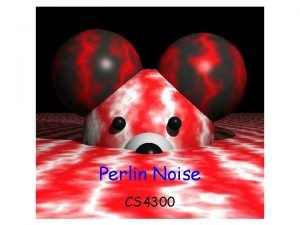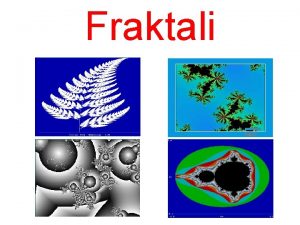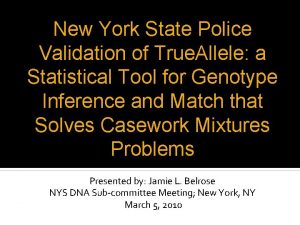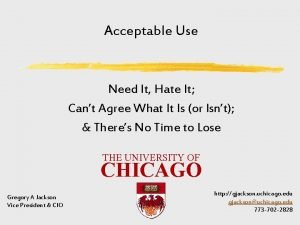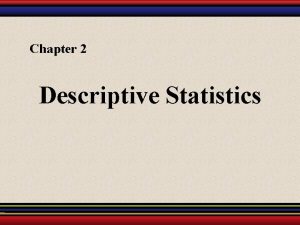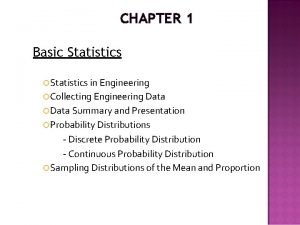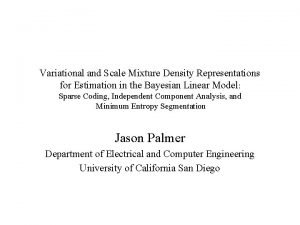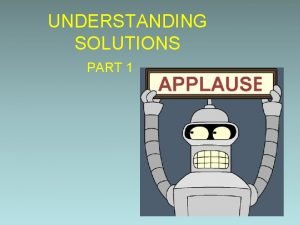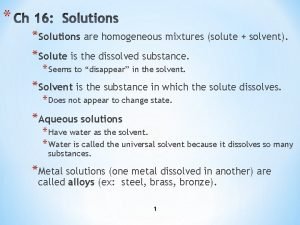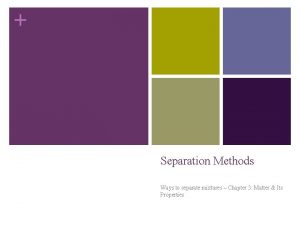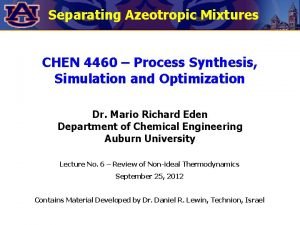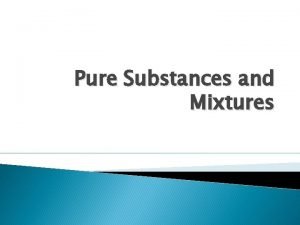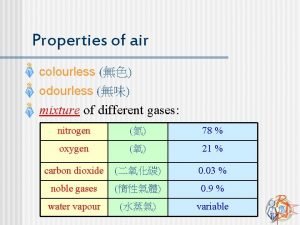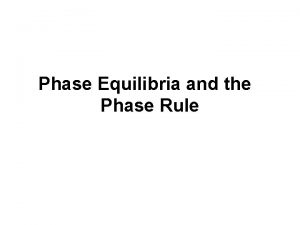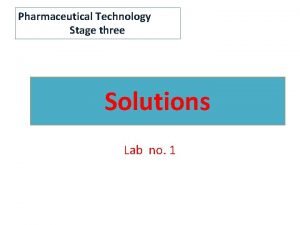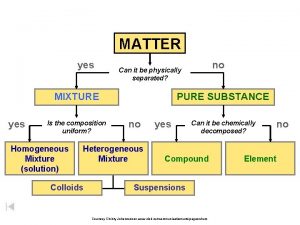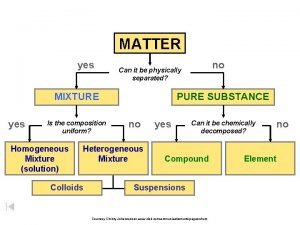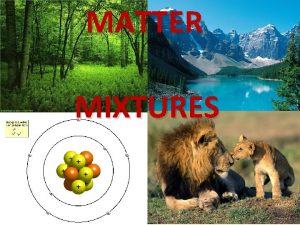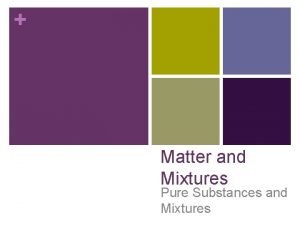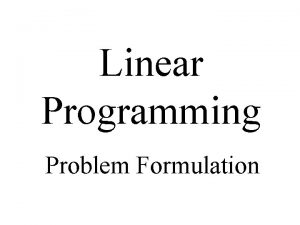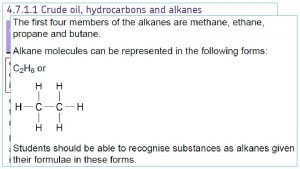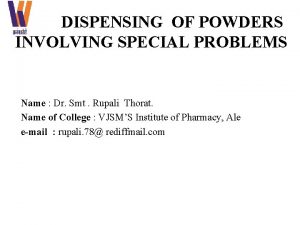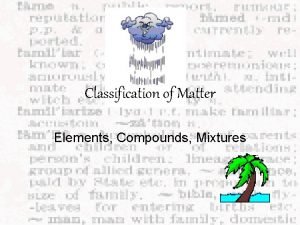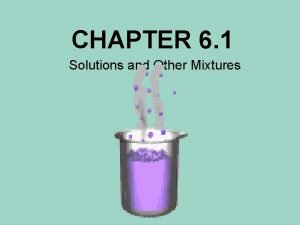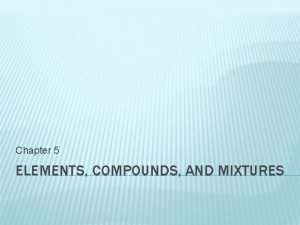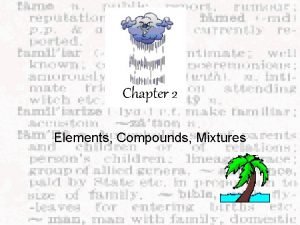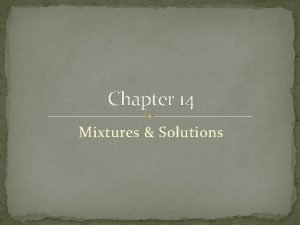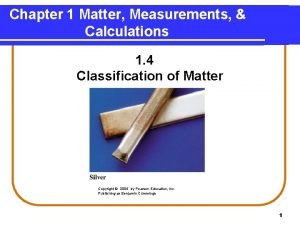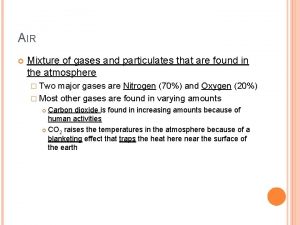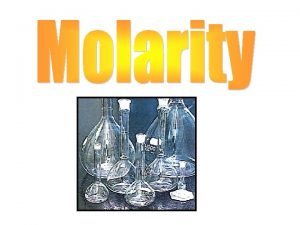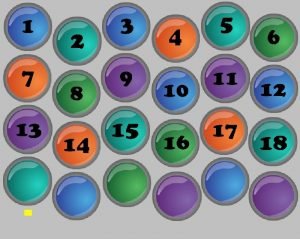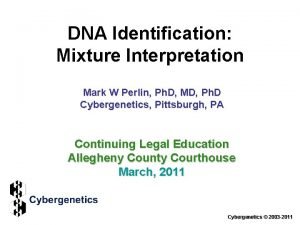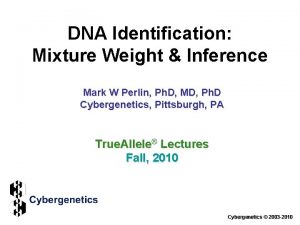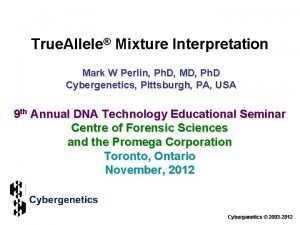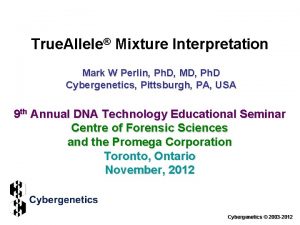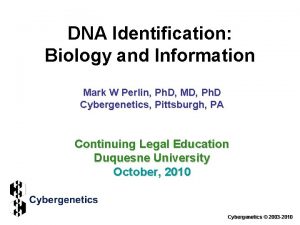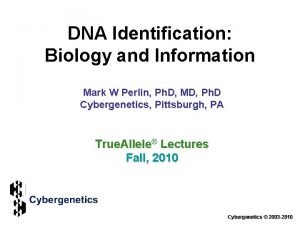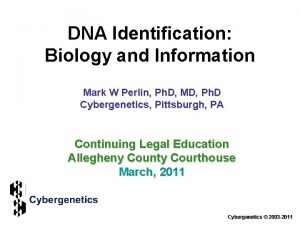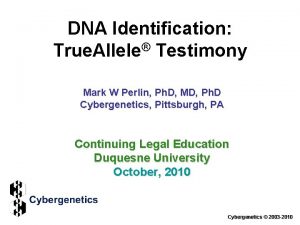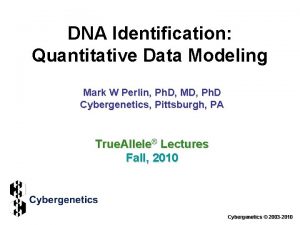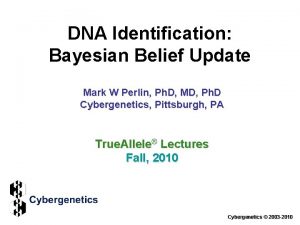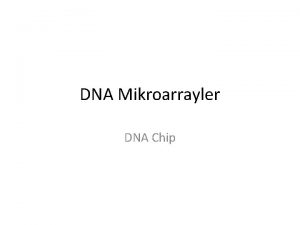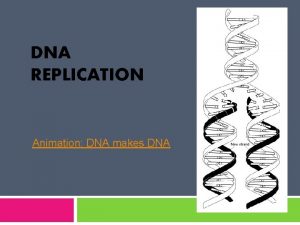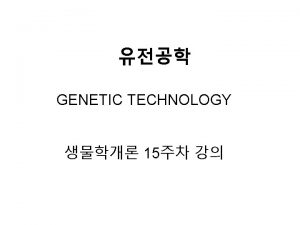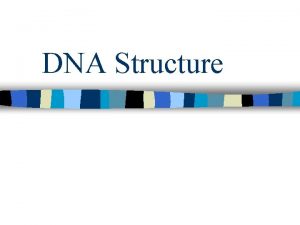DNA Mixture Statistics Mark W Perlin Ph D














































































- Slides: 78

DNA Mixture Statistics Mark W Perlin, Ph. D, MD, Ph. D Cybergenetics, Pittsburgh, PA 2013 Spring Institute Commonwealth's Attorney's Services Council Richmond, Virginia March, 2013 Cybergenetics © 2003 -2013

Child molestation case • June, 2011: Northern Virginia • daughter's birthday slumber party • 10 year old girls sleeping in basement • object sexual penetration • aggravated sexual battery (2 counts) Prosecutor: CDCA Nicole Wittmann

Bathroom Storage Television Cabinet Laundry Bedroom Table CHILD & CHILD VICTIM underpants Bedroom L-Shaped Couch Table VICTIM pajama pants Stairs Bookcase Closet Door to Outside

DNA mixture statistics Human review (using thresholds) • underpants original = 10 million modified = 1 million • pajama pants original = 2 million modified = 4 Computer interpretation requested

Prosecutor question What is the true match information of the evidence to the suspect?

Biology 1 trillion cells

Nucleus cell nucleus

DNA cell nucleus chromosomes

Locus cell chromosomes nucleus locus

Allele cell chromosomes nucleus alleles Short Tandem Repeat (STR) locus

Genotype cell chromosomes nucleus alleles locus Short Tandem Repeat (STR) genotype 7, 8

Identification Evidence item

Identification Evidence item Lab Evidence data 10 12

Identification Evidence item Lab Evidence data Infer Evidence genotype 10, 12 10 12

Identification Evidence item Lab Evidence data Infer Evidence genotype 10, 12 10 12 Compare Known genotype 10, 12

Identification Evidence item Lab Evidence data Infer Evidence genotype 10, 12 10 12 Compare Probability(identification) = Prob(suspect matches evidence) = 100% Known genotype 10, 12

Coincidence Biological population

Coincidence Biological population Lab 10 11 Allele frequency data 12 13 14 15 16 17

Coincidence Biological population Lab 10 11 Allele frequency data Infer 12 13 14 15 16 17 Population genotype 10, 12 @ 5% Genotype product rule, combines alleles Prob(10, 12) = 2 x p 10 x p 12 Prob(10, 10) = p 10 x p 10

Coincidence Biological population Lab 10 11 Allele frequency data Infer 12 13 14 15 16 17 Population genotype 10, 12 @ 5% Compare Known genotype 10, 12

Coincidence Biological population Lab 10 11 Allele frequency data Infer 12 13 14 15 16 17 Probability(coincidence) = Prob(coincidental match) = 5% Population genotype 10, 12 @ 5% Compare Known genotype 10, 12

Identification information At the suspect's genotype, identification vs. coincidence? after (evidence) data before (population) Prob(identification) Prob(coincidence) Evidence changes our belief

Perlin MW. Explaining the likelihood ratio in DNA mixture interpretation. Promega's Twenty First International Symposium on Human Identification, 2010; San Antonio, TX. Match statistic At the suspect's genotype, identification vs. coincidence? after (evidence) data before (population) Prob(evidence matches suspect) Prob(coincidental match)

Match statistic At the suspect's genotype, identification vs. coincidence? after (evidence) data before (population) Prob(evidence matches suspect) Prob(coincidental match) 100% = 5% = 20

Bayes theorem Calculate probability Belief in hypothesis after having seen data Computers, 1985 is proportional to how well hypothesis explains the data times our initial belief. Rev Bayes, 1763 All hypotheses must be considered. Need computers to do this properly. Hypothesis: Defendant contributed to DNA evidence

Mixture interpretation varies National Institute of Standards and Technology Two Contributor Mixture Data, Known Victim 213 trillion (14) 31 thousand (4)

DNA mixture Evidence item +

Uncertainty Evidence item Lab Evidence data + 10 11 12

Uncertainty Evidence item Lab Evidence data Infer Evidence genotype 10, 12 @ 50% 11, 12 @ 30% 12, 12 @ 20% + 10 11 12

Uncertainty Evidence item Lab Evidence data Infer Evidence genotype 10, 12 @ 50% 11, 12 @ 30% 12, 12 @ 20% + 10 11 12 Compare Known genotype 10, 12

Uncertainty Evidence item Lab Evidence data Infer Evidence genotype 10, 12 @ 50% 11, 12 @ 30% 12, 12 @ 20% + 10 11 12 Compare Probability(identification) = Prob(suspect matches evidence) = 50% Known genotype 10, 12

Identification information At the suspect's genotype, identification vs. coincidence? after (evidence) data before (population) Prob(identification) Prob(coincidence) Numerator decreases Denominator unchanged Less weight of evidence, less change in our belief

Match statistic At the suspect's genotype, identification vs. coincidence? after (evidence) data before (population) Prob(evidence matches suspect) Prob(coincidental match) = 50% 5% = 10

True. Allele operator STR evidence data. fsa genetic analyzer files • Replicate computer runs for each item • 2 or 3 unknown mixture contributors • Victim genotype was considered Evidence genotypes probability distributions

DNA mixture data Quantitative peak heights at a locus peak size peak height

True. Allele® Casework View. Station User Client Visual User Interface VUIer™ Software Database Server Interpret/Match Expansion Parallel Processing Computers

Mixture weight Separate mixture data into two contributor components 25% 75%

Genotype inference Thorough: consider every possible genotype solution Objective: does not know the comparison genotype Explain the peak pattern Better explanation has a higher likelihood Victim's allele pair Another person's allele pair

Genotype inference Explain the peak pattern Worse explanation has a lower likelihood Victim's allele pair Another person's allele pair

Genotype separation minor contributor major contributor

Genotype concordance

True. Allele report Genotype probability distributions Evidence genotype Suspect genotype Likelihood ratio (LR) DNA match statistic Population genotype

DNA match statistic 30 x 98% Probability(evidence match) Probability(coincidental match) 3%

Match statistic at 15 loci

True. Allele DNA match LR match to Defendant Underpants Black Caucasian Hispanic 36. 6 quintillion 20. 7 quadrillion 212 quadrillion Pajama pants Black Caucasian Hispanic 319 thousand 3. 86 thousand 32. 9 thousand

Powers of Ten 1 000 … 000 th ou sa m nd illi on bi llio n tri llio n qu ad ril qu lion in til lio n number of zeros -21 -18 -15 -12 -9 -6 -3 0 +3 +6 +9 +12 +15 +18 +21 logarithmic scale

Trial preparation • discuss case report • direct examination • curriculum vitae • Power. Point slides • background reading • answer questions

Computer Interpretation of Quantitative DNA Evidence Commonwealth v Defendant April, 2012 Arlington, Virginia Mark W Perlin, Ph. D, MD, Ph. D Cybergenetics, Pittsburgh, PA Cybergenetics © 2003 -2012

DNA genotype A genetic locus has two DNA sentences, one from each parent. locus mother allele 1 2 3 4 5 6 7 8 ACGT repeated word father allele 1 2 3 4 5 6 7 8 9 An allele is the number of repeated words. A genotype at a locus is a pair of alleles. 8, 9 Many alleles allow for many allele pairs. A person's genotype is relatively unique.

DNA evidence interpretation Evidence item Lab Evidence data Infer Evidence genotype 10, 12 @ 50% 11, 12 @ 30% 12, 12 @ 20% 10 11 12 Compare Known genotype 10, 12

Computers can use all the data Quantitative peak heights at locus Penta E peak size peak height

How the computer thinks Consider every possible genotype solution Victim's allele pair Explain the peak pattern Better explanation has a higher likelihood Another person's allele pair

Evidence genotype Objective genotype determined solely from the DNA data. Never sees a suspect. 98% 1%

DNA match information How much more does the suspect match the evidence than a random person? 30 x 98% Probability(evidence match) Probability(coincidental match) 3%

Match information at 15 loci

Is the suspect in the evidence? A match between the underpants and Defendant is: 36. 6 quintillion times more probable than a coincidental match to an unrelated Black person 20. 7 quadrillion times more probable than a coincidental match to an unrelated Caucasian person 212 quadrillion times more probable than a coincidental match to an unrelated Hispanic person

Is the suspect in the evidence? A match between the pajama pants and Defendant is: 319 thousand times more probable than a coincidental match to an unrelated Black person 3. 86 thousand times more probable than a coincidental match to an unrelated Caucasian person 32. 9 thousand times more probable than a coincidental match to an unrelated Hispanic person

Outcome Guilty • object sexual penetration • two counts of aggravated sexual battery Sentence • 22 years imprisonment Court of Appeals • DNA chain of custody • appeal denied

True. Allele mixture validation: Virginia case study Establish the reliability of True. Allele mixture interpretation Mark W Perlin, Ph. D, MD, Ph. D Kiersten Dormer, MS and Jennifer Hornyak, MS Cybergenetics, Pittsburgh, PA Lisa Schiermeier-Wood, MS and Susan Greenspoon, Ph. D Department of Forensic Science, Richmond, VA

Case composition • 72 criminal cases • 92 evidence items • 111 genotype comparisons Criminal offense • 18 homicide • 12 robbery • 6 sexual assault • 20 weapon

DNA mixture distribution

Data summary – “alleles” Over threshold, peaks are labeled as allele events All-or-none allele peaks, each given equal status Threshold Allele Pair 7, 7 7, 10 7, 12 7, 14 10, 10 10%10, 12 10, 14 12, 12 12, 14 14, 14

CPI information Combined probability of inclusion Nothing reported 2. 26 25 6. 70 CPI

SWGDAM 2010 guidelines Higher threshold for human review Under threshold, alleles less used Threshold Allele Pair 7, 7 7, 10 7, 12 7, 14 10, 10 0%10, 12 10, 14 12, 12 12, 14 14, 14

Modified CPI information 2. 26 56 Nothing reported 1. 75 25 2. 12 6. 70 CPI m. CPI

SWGDAM 2010 guidelines 3. 2. 2. If a stochastic threshold based on peak height is not used in the evaluation of DNA typing results, the laboratory must establish alternative criteria (e. g. , quantitation values or use of a probabilistic genotype approach) for addressing potential stochastic amplification. The criteria must be supported by empirical data and internal validation and must be documented in the standard operating procedures. Use True. Allele® Casework for DNA mixture statistics

Validated genotyping method Perlin MW, Sinelnikov A. An information gap in DNA evidence interpretation. PLo. S ONE. 2009; 4(12): e 8327. Perlin MW, Legler MM, Spencer CE, Smith JL, Allan WP, Belrose JL, Duceman BW. Validating True. Allele® DNA mixture interpretation. Journal of Forensic Sciences. 2011; 56(6): 1430 -47. Perlin MW, Belrose JL, Duceman BW. New York State True. Allele® Casework validation study. Journal of Forensic Sciences. 2013; 58(6): in press.

True. Allele reinterpretation Virginia reevaluates DNA evidence in 375 cases July 16, 2011 “Mixture cases are their own little nightmare, ” says William Vosburgh, director of the D. C. police’s crime lab. “It gets really tricky in a hurry. ” “If you show 10 colleagues a mixture, you will probably end up with 10 different answers” Dr. Peter Gill, Human Identification E-Symposium, 2005

Mixture weight Separate mixture data into two contributor components 25% 75%

Genotype inference Thorough: consider every possible genotype solution Objective: does not know the comparison genotype Allele Pair Victim's allele pair 7, 7 7, 10 Explain the 7, 12 Another person's peak pattern 7, 14 allele pair 10, 10 98%10, 12 10, 14 12, 12 Better 12, 14 explanation 14, 14 has a higher likelihood

True. Allele sensitivity 2. 26 56 Nothing reported 1. 75 5. 52 25 9 2. 12 6. 70 10. 93 CPI m. CPI True. Allele

True. Allele specificity True exclusions, without false inclusions – 19. 69

True. Allele reproducibility log(LR 2) Concordance in two independent computer runs standard deviation (within-group) 0. 305 log(LR 1)

Validation results True. Allele® Casework DNA mixture interpretation is: A reliable method • sensitive • specific • reproducible True. Allele computer genotyping is more effective than human review

True. Allele Virginia outcomes 144 cases analyzed 72 case reports – 10 trials City Court Charge Sentence Richmond Federal Weapon 50 years Alexandria Federal Bank robbery 90 years Quantico Military Rape Chesapeake State Robbery 26 years Arlington State Molestation 22 years Richmond State Homicide 35 years Fairfax State Abduction 33 years Norfolk State Homicide 8 years Charlottesville State Homicide 15 years Hampton State Home invasion 3 years 5 years

True. Allele in Virginia • Department of Forensic Science has their own True. Allele system • Training, validation, approvals • Services centralized in Richmond • DFS will provide DNA mixture statistics and court testimony

True. Allele in the United States Casework system Interpretation services

More information http: //www. cybgen. com/information • Courses • Newsletters • Newsroom • Presentations • Publications perlin@cybgen. com
 Ken perlin
Ken perlin Fraktal
Fraktal Dr barry perlin
Dr barry perlin Darryl perlin santa barbara
Darryl perlin santa barbara Ken perlin
Ken perlin Is 14 karat gold homogeneous or heterogeneous
Is 14 karat gold homogeneous or heterogeneous Function of dna polymerase 3
Function of dna polymerase 3 Bioflix activity dna replication dna replication diagram
Bioflix activity dna replication dna replication diagram Coding dna and non coding dna
Coding dna and non coding dna The principal enzyme involved in dna replication is
The principal enzyme involved in dna replication is Dna and genes chapter 11
Dna and genes chapter 11 Introduction to statistics what is statistics
Introduction to statistics what is statistics Elementary statistics chapter 2
Elementary statistics chapter 2 Standard deviation formula for ungrouped data
Standard deviation formula for ungrouped data Soil is a mixture of what
Soil is a mixture of what Density of mixture formula
Density of mixture formula Is cake batter a pure substance or a mixture
Is cake batter a pure substance or a mixture Suspension mixture
Suspension mixture The atmosphere is a mixture of ___________.
The atmosphere is a mixture of ___________. Substance vs mixture
Substance vs mixture Solving mixture problems
Solving mixture problems What is homogeneous mixture
What is homogeneous mixture A homogeneous mixture of a solute and solvent
A homogeneous mixture of a solute and solvent Soil is a mixture of weathered rock and
Soil is a mixture of weathered rock and Soil layers
Soil layers Homogeneous mixture
Homogeneous mixture Stemless funnel function
Stemless funnel function Sifting mixture
Sifting mixture Pictures of mixtures
Pictures of mixtures Azeotrope
Azeotrope A yolk and cream mixture that is used to thicken liquids
A yolk and cream mixture that is used to thicken liquids Clastic rocks examples
Clastic rocks examples Is limestone a element compound or mixture
Is limestone a element compound or mixture A substance
A substance Air is a mixture of colourless
Air is a mixture of colourless Two component system containing liquid phase
Two component system containing liquid phase Solution 1 2 3
Solution 1 2 3 Chex mix mixture or solution
Chex mix mixture or solution Solutions and mixtures
Solutions and mixtures Properties of mixture
Properties of mixture Suspension mixture
Suspension mixture Mixture examples
Mixture examples What is a mixture in chemistry
What is a mixture in chemistry Uniform matter
Uniform matter Composition uniform
Composition uniform Heterogeneous mixture
Heterogeneous mixture Matter classification flow chart
Matter classification flow chart Mixture
Mixture What is steel a mixture of
What is steel a mixture of Volume solid liquid gas
Volume solid liquid gas Shaving mirror lost at sea
Shaving mirror lost at sea Linear programming problem formulation
Linear programming problem formulation Alcohol covalent bond
Alcohol covalent bond Pure substance examples
Pure substance examples Training gaussian mixture models at scale via coresets
Training gaussian mixture models at scale via coresets Producer gas is a mixture of
Producer gas is a mixture of Substance
Substance Is raisin bran a compound
Is raisin bran a compound Periodic table mixtures
Periodic table mixtures Is a rock an element compound or mixture
Is a rock an element compound or mixture Deliquescent powders are...
Deliquescent powders are... Mixture graphic organizer
Mixture graphic organizer Difference between mixture and compund
Difference between mixture and compund Suspension mixture
Suspension mixture Is kool aid an element compound or mixture
Is kool aid an element compound or mixture Chapter 4 basic food chemistry the nature of matter
Chapter 4 basic food chemistry the nature of matter Is pepperoni pizza an element compound or mixture
Is pepperoni pizza an element compound or mixture Difference between mixture and compound
Difference between mixture and compound Colloids mixture
Colloids mixture Why blood is heterogeneous mixture
Why blood is heterogeneous mixture Concrete mixture ratio
Concrete mixture ratio Is tap water a heterogeneous mixture
Is tap water a heterogeneous mixture Air mixture of gases
Air mixture of gases A solution is a homogeneous mixture
A solution is a homogeneous mixture Intermediate sized particles
Intermediate sized particles Heterogeneous mixture vinegar
Heterogeneous mixture vinegar Which grand sauce is made from milk and white roux
Which grand sauce is made from milk and white roux Compounds and mixtures worksheet
Compounds and mixtures worksheet How long does the weathering process take brainpop
How long does the weathering process take brainpop
